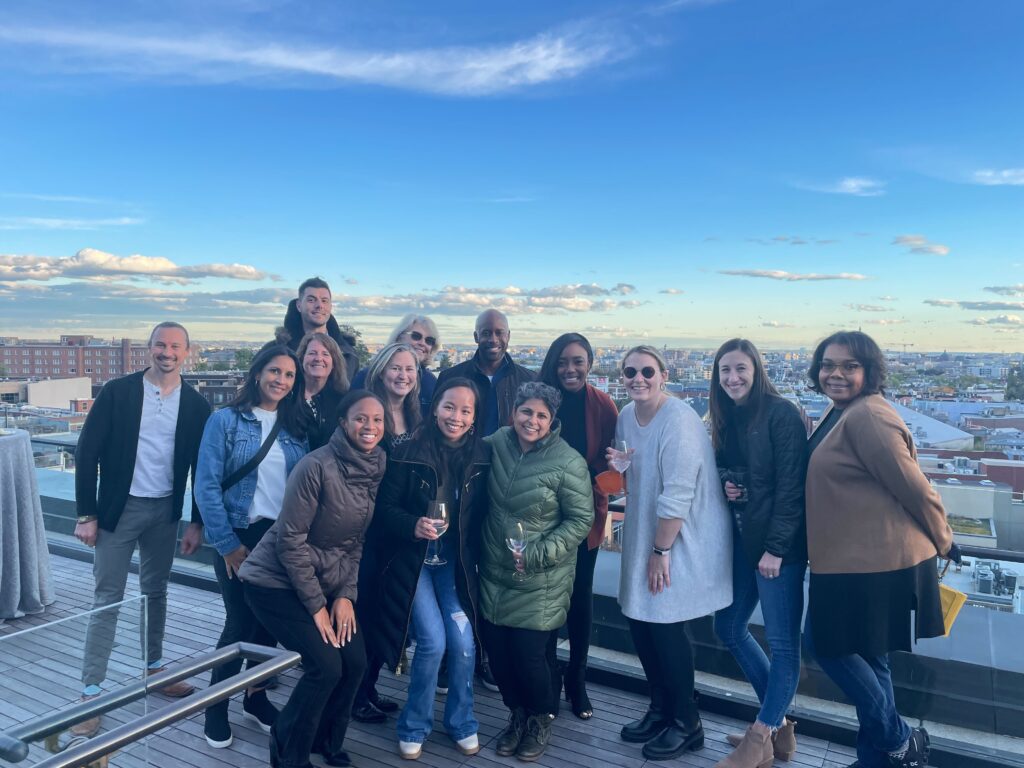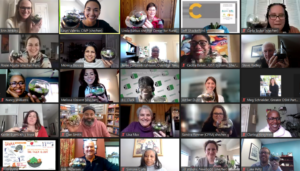Together We Thrive: 5 Elements that Define a Thriving Organization
ProInspire Director Monica Biswas shares insights from her work with organizations this year. She explores 5 elements she has observed across thriving organizations. Enjoy the third blog installment in our Thrive Through the Season and into 2023 campaign.
In terms of commitment, thriving organizations recognize that race equity cannot be solely held by a single role, such as a Chief Diversity Officer, or a group, such as an Employee Resource Group or even an entire HR department. Instead, thriving organizations share responsibility across departments and roles, including voices from different identities and positions in decision-making.
What does it look like for an organization to be thriving?
This question is an energizing one for ProInspire because we believe that a thriving organization requires that all staff, in particular staff of color, are experiencing inclusion and equity. While I don’t have one single answer of what this looks like, I have gleaned insights from the organizations I work with in my role as Director at ProInspire. Despite different contexts, industries, and sizes, there are similarities when it comes to defining “thriving” and the factors to look for in your organization.
What does strategy look like in a thriving organization?
In all organizations that I have the privilege of working with, I see evidence of an intention and commitment to work on racial equity. This goes beyond a public statement on their website and can come in various forms.
Some organizations align their values to racial equity and then work continuously to live into those values through policies, programs, and culture. Another approach is to explicitly name racial equity and its connection to the organization’s vision and/or mission. When integrated into the overall strategy, organizations are more able to make commitments of resources that span over multiple years.
In terms of commitment, thriving organizations recognize that race equity cannot be solely held by a single role, such as a Chief Diversity Officer, or a group, such as an Employee Resource Group or even an entire HR department. Instead, thriving organizations share responsibility across departments and roles, including voices from different identities and positions in decision-making.
For example, in ProInspire’s work with People Practices for Race Equity Alignment (PPREA) community of practice, funded by the Kresge Foundation, teams from multiple organizations came together to learn and develop a race equity plan for their organization over eight months. This team-based approach ensured that there were diverse identities and perspectives in the group: an executive, an HR lead, and at least two other staff members from different parts of the organization.
Through collective learning and discussions, nearly every participant indicated that they strengthened relationships with the members of their organizational team and we noticed that it led to more robust and informed race equity plans.
What does leadership look like in a thriving organization?

In thriving organizations, I see leadership challenging traditional norms of hierarchy and structures that centralize power among those at “the top.” Leadership is exercised throughout the organization, in the form of race equity change committees and workgroups that bring people of varying levels of positional authority together to make decisions. I observe leaders value staff’s lived experiences as a type of expertise, along the same lines as academic or other credentials.
Aimee Laramore, a participant in our PPREA program and a Director at the Dorothy A. Johnson Center for Philanthropy speaks about leadership in thriving race equitable organizations:
“Leaders do not pretend to know all the answers, but have intense curiosity about what we might do together to be better. Leaders are vulnerable — because vulnerability allows us to get unstuck. Leaders in thriving organizations have a culture of generosity; they ask and allow thoughtful questions, engage in generative thinking, and are grateful for the opportunity to lead.”
Organizationally, those leaders advocate for transparent review and sharing of HR data—disaggregated by race, ethnicity, and other dimensions—on hiring, promotions, attrition, and turnover. We see organizations not trying to make their data appear perfect, but looking to do better and to do right by employees, especially employees of color.
What does culture look like in a thriving organization?
I once heard a participant say, “Culture eats policy for breakfast.” They weren’t wrong! What this means is that even when racial equity is built into written policies, if the internal culture is still steeped in white supremacy norms, those policies will be overlooked or not enforced and real change cannot sustain. In race equitable organizations that are thriving, I see organizations examining their culture and working to shift away from norms like working with a continuous sense of urgency, perfectionism, fear of conflict, or right to comfort.
I also observe organizations working to increase trust throughout the organization — in peer relationships, with managers, between departments, with leadership and the Board, and with communities. This could be as simple as meeting norms that start with “how are you?” or a check-in that honors the whole human before immersing in the tasks at hand. Meetings or retreats may be held for the primary purpose of building or deepening relationships and trust.
Sometimes trust can be hard to recognize. When doing racial equity work, difficult truths emerge, and disagreements can surface. If a group is averse to conflict, those disagreements might be uncomfortable and seen as a sign of broken trust.
However, conflict is not necessarily a bad thing. In fact, principled disagreements are a sign that people are willing to engage and want the organization to live more fully up to its values. At ProInspire, we held a retreat and engaged in challenging discussions about conflict, which had a negative impact on staff of color and, in particular, Black women within our organization. As a team, we wrestled with the impacts for many months following the retreat. While these conversations felt messy and uncomfortable for me at times, in retrospect, I have come to appreciate that they were a signal of our growing trust. Without trust, we would not have named the hard things, and we wouldn’t have stayed in relationship with each other long enough to examine the complexities together.
Thriving organizations understand that racial equity work is more than “the work” itself. It is about reimagining who we feel accountable to, how we relate to one another and the ways we work together.
What does representation look like in a thriving organization?
Though this is an important question, I intentionally did not ask it first in this article because my colleagues and I are seeing that when an organization is committed to advancing racial equity — through strategy, leadership, and culture – representation follows [Chronicle of Philanthropy].
In a thriving organization, staff of color see themselves as thriving in that environment. Staff of color feel psychologically safe, are able sustain their personal needs through the salary and benefits of the job, and feel aligned with the mission, vision, and impact of the organization. As a result, staff of color are not leaving at any greater rates than white staff.

In ProInspire’s work with the Spark program, funded by the Kauffman Foundation, some white-led organizations were focused on addressing racial equity by only investing in expanding pipelines for recruitment to increase diversity. When they began to look at attrition, they found that their greater challenge was actually retaining staff of color.
If your organization is not yet disaggregating retention and other data by race, ethnicity, gender, or other dimensions, that is one foundational recommendation I have for you. Without it, you may be missing crucial information. For instance, I recall an organization where BIPOC and white staff had similar rates of attrition. Further disaggregation, however, illuminated that Black and Latinx staff attrition was significantly higher than Asian American or white staff, which required a different set of approaches than expanded pipelines.
What does community impact look like in a thriving organization?
This is the next horizon question for us at ProInspire. Our hypothesis is that working towards racial equity in social sector organizations will ultimately contribute to thriving communities of color. We’re excited by all of the possibilities to explore this question more deeply in 2023!
Closing Thoughts
From the organizations I have worked with, I have observed that the path to becoming a thriving organization can start almost anywhere — strategy, leadership, or culture. The important thing is that organizations respond to their specific context — listening to what BIPOC staff are naming as the greatest needs and working collaboratively to respond to that.
Thriving organizations understand that racial equity work is more than “the work” itself. It is about reimagining who we feel accountable to, how we relate to one another and the ways we work together. Ultimately, this work is shared and embodied by every corner of the organization — from staff, leadership, and Boards.
Grounded in our four Core Commitments, we are exploring what it mean to thrive – as leaders, as an organization, and as a sector. Monica’s blog is the third of four in our Thrive Through the Season and into 2023 campaign. Learn more about the Core Commitments by downloading our Self to Systems: Leading for Race Equity Impact and sign up for our newsletter for our emerging thoughts, highlights, and insights you can take into the new year.
Read the previous blog installments in our Thrive Through the Season and into 2023 campaign:
- “Succession is Not a Dirty Word” by Founder & Co-CEO Monisha Kapila
- “Get on Board: How Centering Relationships Can Guide Governance” by ProInspire Board Chair Nancy Withbroe

Director, ProInspire
